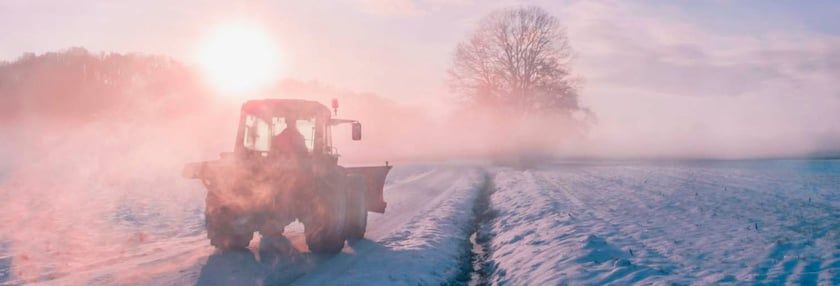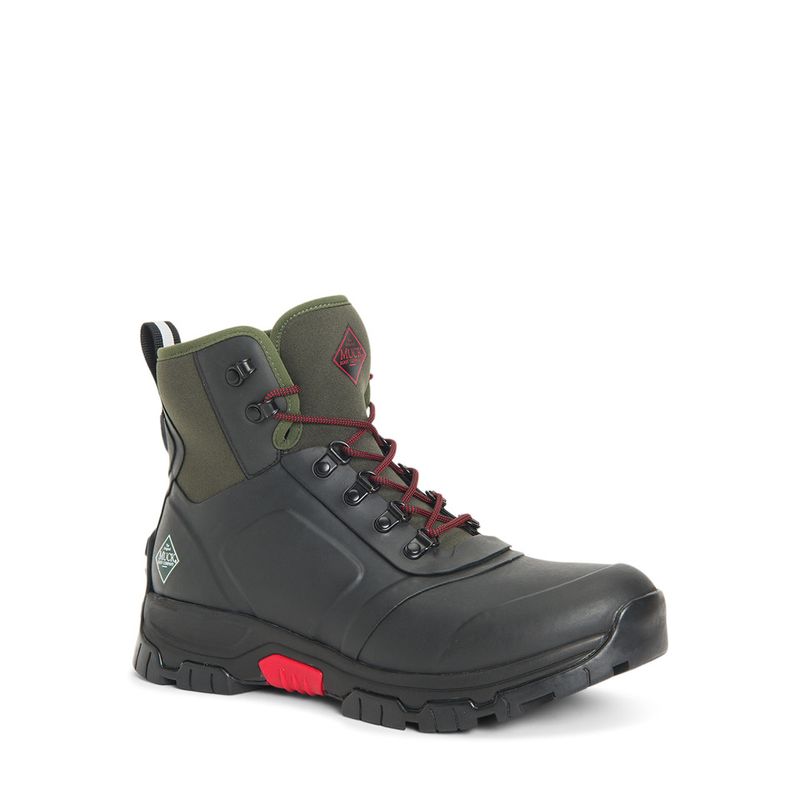C-c-c-cold Weather


Is your tractor up to it? Are you?
Unlike many farm equipment pieces, the tractor is called upon nearly every day. Usually we just climb on, turn the key, and put it to work. For three seasons, all is good, but then…
Without proper winterizing, you can’t count on that level of service, and things can go very wrong. Here’s what to check, change, and adjust in anticipation of the coming Polar Vortex days
Diesel Fuel
When you buy a tractor in the summer, no one mentions the “cloud point” of the diesel fuel to use. That’s the temperature when No. 2 diesel becomes cloudy with crystals that can clog your fuel filter. That’s at about 14° F. and an industry rule of thumb is that you need another 15 degrees’ safety margin beyond that. So if mornings are frosty already (call it 30° F.), it’s time to begin blending your stored diesel with No.1 diesel.
Most truck stops and fuel suppliers begin blending fuel for the season. Alternatively, you can add an anti-gelling compound, sold at most auto parts stores, or your equipment dealership.
Battery
Cold weather means the amount of current to start a cold engine increases and cold-cranking amps available decreases—it’s not a good formula. Frequent starts and stops further reduce power. “Be ready for battery (problems)” says Case Construction Equipment’s Ted Polzer. “Batteries are always the thing that tend to plague everybody.”
Case’s Josh Goldsworthy advises to make sure your battery is fully charged heading into winter. You may even want to remove the battery for a refreshing spell on a bench-top charger.
Coolant
If it’s not hot outside, why do I need to check my coolant? That’s because it will freeze. Seriously.
Pull out your hydrometer and make sure the mix is good for well below -20° F. What, you don’t have one? They’re under $10 from amazon.com, big box stores, or the local parts store, and they’ll save you heartache and hundreds of dollars.
While you’re at it, make sure your radiator is cleared of all the dust and debris from a long summer’s use.
Hydraulics
Most tractor owners consider their hydraulics to be maintenance-free. If there isn’t a leak, why worry about it, right? If that’s your attitude, consider changing it.
Cold causes hydraulic fluid molecules to crystallize, meaning things can freeze up, and when that happens, just about anything in the system can break. Expensively.
The smart thing is to read your owner’s manual or contact the local dealership for advice on proper hydraulic fluid for winter (and for summer, too). The pump you save may be your own.
Cab environment
Does everything in the cab work, including heated seats? Check the door and window seals to make sure they are intact. Check and blow out the cab air filter. “Even simple things like making sure the windshield wipers are in proper working order is important,” says Case Construction Equipment’s Ted Polzer.
If you don’t have a cab, your seat will take all the abuse from Mother Nature. Make sure it is clean going into the winter season, and tilt it forward when not in use to drain water…or ice. Many tractors have a safety switch beneath, so that should be ice-free as well.
Attachments and implements
Mike Wiles, who produces Ask Tractor Mike on YouTube.com, urges people to apply a thin film of grease to the shiny hydraulic rams of your front end loader. They will be exposed to a lot of weather, and this will help protect them.
He also suggests removing any PTO shafts from the tractor, cleaning them, and giving a coat inside and out with a protectant like WD-40. Then store them in the garage or barn until next spring. This way, you’ll prevent surface rust and the PTO shaft will extend like it’s new.
If you have mowers and other PTO-powered equipment stored outside, Tractor Mike recommends putting a covering over the gearbox.
Don’t forget to fully winterize any sprayers you used. Begin by completely emptying the reservoir (by spraying out, not draining it). Then, Tractor Mike recommends adding (typically pink-colored) RV antifreeze and running that through the sprayer until all the nozzles show pink spray—DO NOT use automotive antifreeze.
Tractor Mike shows how to winterize your sprayer
Have more questions on winterizing your equipment? Ask Tractor Mike!
Are you ready for the weather?
Farm work can be hard enough during pleasant seasons, but it can get downright challenging when things get icy.

Hand it to yourself
Hands are often the first to feel winter’s grip. Comfortable well-bedded-in chore gloves that were for summer work offer little cold-weather protection. Time to move to sturdy insulated gloves; dexterity and ability to thread a nut onto a stud will go out the window, but at least you’ll be able to feel your fingers when going inside. Maybe.
Boots and shoes
Frozen ground presents unique challenges. Not only can it suck the heat out of your feet, but between snow and ice—or frozen slush or mud—you need an extra level of sure-footedness.
Clumsy, old-fashioned two buckle overshoes or 3- or 4- buckle boots were the standard. In addition to being waterproof, they featured thick soles to keep some distance between your feet and heat-sucking cold. Today, people are finding as much comfort and traction with modern designs—hey, they’re even fashionable!—with attractive out-of-barn colors and handy grips for pulling on and off.

The Original Muck Boot Company (muckbootcompany.com) has designed several good-looking models with knobby extra-thick soles for grip and comfort, plus insulation where you need it the most. The Muck Arctic Ice AGAT Tall and Mid Boots for men and women provide grip on wet or dry hard surfaces through the use of the Vibram XS Trek Evo compound—meaning you can use the boots beyond winter.
Don’t forget socks, which add an extra layer of insulation. You want wool. Period. Cotton doesn’t do the job in the winter, and wool retains your body heat even when damp or wet. Pro tip: Slip your feet into sock liners (essentially a lightweight synthetic sock) and then don the wool.
Body heat
Nothing does the job of protecting you against cold than insulated coveralls. Usually these are thick canvas with layers of insulation stitched inside. Bib overalls are easier to slip on and off, while full body coveralls provide protection and warmth without exposing any skin. Either way, make sure they are loose-fitting to trap insulating air.
Headwear
Like socks, headwear that contains wool will keep your head warm, even when you perspire. Whether you prefer a stocking cap, regular hat, fur trapper design, or something with a holiday vibe, you want your ears covered. For extreme cold weather, invest in a balaclava or other full-face covering.
Tags:Tool Time

Acreage Life is part of the Catalyst Communications Network publication family.
















